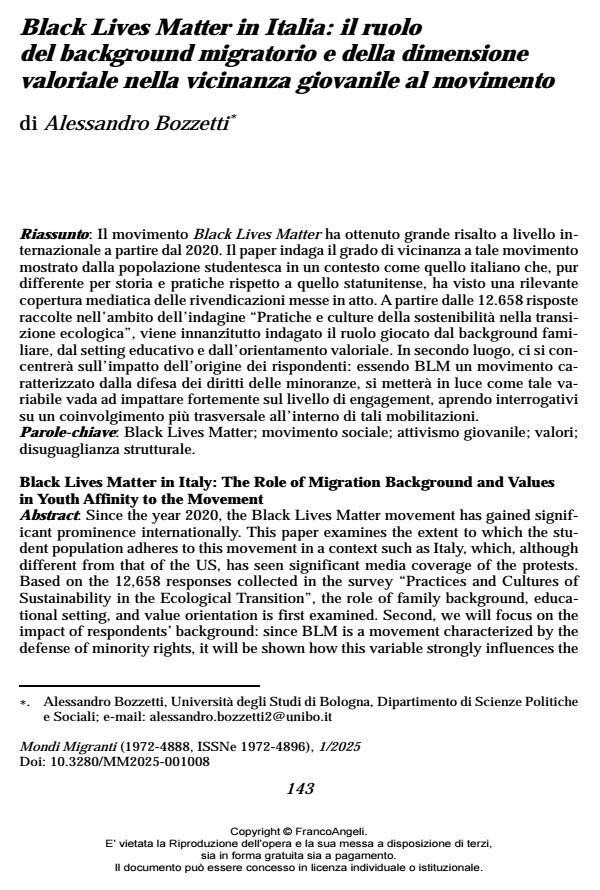Black Lives Matter in Italia: il ruolo del background migratorio e della dimensione valoriale nella vicinanza giovanile al movimento
Titolo Rivista MONDI MIGRANTI
Autori/Curatori Alessandro Bozzetti
Anno di pubblicazione 2025 Fascicolo 2025/1
Lingua Italiano Numero pagine 24 P. 143-166 Dimensione file 224 KB
DOI 10.3280/MM2025-001008
Il DOI è il codice a barre della proprietà intellettuale: per saperne di più
clicca qui
Qui sotto puoi vedere in anteprima la prima pagina di questo articolo.
Se questo articolo ti interessa, lo puoi acquistare (e scaricare in formato pdf) seguendo le facili indicazioni per acquistare il download credit. Acquista Download Credits per scaricare questo Articolo in formato PDF

FrancoAngeli è membro della Publishers International Linking Association, Inc (PILA)associazione indipendente e non profit per facilitare (attraverso i servizi tecnologici implementati da CrossRef.org) l’accesso degli studiosi ai contenuti digitali nelle pubblicazioni professionali e scientifiche
Il movimento Black Lives Matter ha ottenuto grande risalto a livello internazionale a partire dal 2020. Il paper indaga il grado di vicinanza a tale movimento mostrato dalla popolazione studentesca in un contesto come quello italiano che, pur differente per storia e pratiche rispetto a quello statunitense, ha visto una rilevante copertura mediatica delle rivendicazioni messe in atto. A partire dalle 12.658 risposte raccolte nell’ambito dell’indagine “Pratiche e culture della sostenibilità nella transizione ecologica”, viene innanzitutto indagato il ruolo giocato dal background familiare, dal setting educativo e dall’orientamento valoriale. In secondo luogo, ci si concentrerà sull’impatto dell’origine dei rispondenti: essendo BLM un movimento caratterizzato dalla difesa dei diritti delle minoranze, si metterà in luce come tale variabile vada ad impattare fortemente sul livello di engagement, aprendo interrogativi su un coinvolgimento più trasversale all’interno di tali mobilitazioni.
Parole chiave:Black Lives Matter; movimento sociale; attivismo giovanile; valori; disuguaglianza strutturale.
Alessandro Bozzetti, Black Lives Matter in Italia: il ruolo del background migratorio e della dimensione valoriale nella vicinanza giovanile al movimento in "MONDI MIGRANTI" 1/2025, pp 143-166, DOI: 10.3280/MM2025-001008